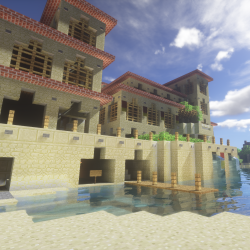The PCB wiki has now been archived and is read-only. |
Verona
Verona was a rustic Italian themed city founded by tomicalover for the 1.7 Creative Map.
|
A view of Verona from the beach. | |
| Founder | tomicalover |
|---|---|
| Map | Creative 1.7 |
| Theme | Italian Rustic |
It is located at x:423 y:63 z:1760
History
According to folk lore, Old Verona began as a trade city centered around maritime trade routes. This led the city to become incredibly prosperous and, in turn, advanced development of arts and culture. The area of Old Verona is believed to be upwards of 8,000 hectares including the surrounding farmland.
Disaster
Some time during Old Verona's peak happened 'The Great Earthquake' often described in historical documentation. Scholars today speculate the earthquake was likely in the range of 8-9 on the Richter scale. This devastated Verona leaving the large city in shambles. It is estimated that as much as 5,000 lives were lost as a result directly of the earthquake and of the famine that ensued. Verona became abandoned in the following months.
Reconstruction
A few years after the disaster, settlers from the North stumbled upon the ruins of Verona, recounting the numerous stories they heard about the once great city. Similar in culture, they decided to claim Verona for themselves and rebuild it. What stands today is a result of the reconstruction of Old Verona although paling in size to its original.
Design
The design of Verona centered around a few key materials: Sandstone, brick, and fence. The residential and commercial buildings in Verona were created using a standardized system of arches that could be expanded infinitely and, effectively, in any shape.
Great Hall
The warp hall of Verona was built in the style of Greek temple featuring undecorated doric columns supporting a brick pediment. The structure did not use the pattern system laid out for most residential buildings.
Great Bath
Directly behind the Great Hall was the Great Bath; which also did not utilize the building system. It featured an open roof to allow the heat of the baths to ventilate upwards.
Imperial Palace
Using the arch system, the Great Palace was constructed for the ruling elite of Verona. It is the largest domicile in the city with more than ten rooms and a private dock.
Gardens and Statue of Athena
The Great Garden featured a surrounding collonade with a reflecting pond at its center and numerous fountains. The statue (built in quartz) was dedicated to Athena, who gave the settlers the power to rebuild Verona.
Infrastructure
Verona's streets were intentionally narrow to provide a greater sense of comfort and connectivity to the city. Verona has no outside connections to roads, so the city may only be accessed by the entrance at the beach or by boat to one of its numerous public and private docks.
Verona utilised an aqueduct to transport fresh water into the city. It was designed in the style of the Roman aqueduct.
Transportation
Rail
Verona connected to the nearby Raymont through its own regional line operated by National Railways. The trip from Verona Station to the city of Raymont took approximately 2 minutes 45 seconds.
Land
Verona had no connection with any road, it could only be accessed on foot, boat, or by the metro.
Water
Due to Verona's location by the sea, boat travel was a practical way to get to the city.
